duet
Haydn - Fantasia in C Major - Flute & Clarinet
 Fantasia in C major, by F. J. Haydn
Fantasia in C major, by F. J. HaydnArranged as a Duet for Flute and Clarinet by John W. Pratt
Flute Part, A Clarinet Part, and Mini-Score ― PDF $12.99
Fantasia in C major (Op.58; Hob. XVII:4) was written by Haydn in 1789 for the pianoforte. Based on a folk song about a farmer's wife chasing her cat, one can easily imagine in the music kittenish scampering, stealthy approaches, unexpected pounces, and mad chases with abrupt changes of direction. The style and playfulness of the piece lend themselves well to flute and clarinet. The transcription is able to capture the feel Haydn intended, with new coloring, while at the same time affording flutists and clarinetists the joy of experiencing the work first-hand. (adapted from JWP's foreword to the edition)
Flute part, 6 pages; Clarinet in A part, 6 pages; Mini-score in concert pitch, 6 pages; Total, 24 pages.
PreviewHerman - Grands Duos Concertantes - Two Flutes
 Trois Grands Duos Brillants et Mélodiques pour Deux Flûtes Concertantes, by Jules Herman
Trois Grands Duos Brillants et Mélodiques pour Deux Flûtes Concertantes, by Jules HermanNew Editions by Noteworthy Sheet Music, with a Foreword by P. H. Bloom
Duo 1: Flute 1 Part, Flute 2 Part, and Mini-Score ― PDF $17.98
Duo 2: Flute 1 Part, Flute 2 Part, and Mini-Score ― PDF $21.75
Duo 3: Flute 1 Part, Flute 2 Part, and Mini-Score ― PDF $17.98
Jules Herman's Grands Duos Concertantes (Opus 86) are works of ingenuity, charm, brilliance, grace, and humor. Long overlooked, they are extraordinarily fine examples of concert-worthy duets of the late 19th century. Originally published by Choudens in Paris about 1885, the Grand Duos were dedicated to composer François-Auguste Gevaert (1828–1908), then director of the Royal Conservatory of Brussels. Flutists will find these works challenging and rewarding, teachers of advancing students will be amazed by their utility, and audiences will be enchanted. (excerpted from PHB's © foreword)
Note that these duets make for excellent sight-reading training... the music is interesting and demanding, and the parts are nicely balanced. All three duets have three movements each. Duo 1: Allegro moderato; Adagio sostenuto; and Rondo allegro. Duo 2: Moderato; Scherzando; and Polonaise. Duo 3: Allegretto vivace con brio; Air Varié, Andante; and Boléro, Moderato.
Duo 1: Fl 1 & Fl 2 Mini-Score, 12 pages 2-up; Flute 1 part, 12 pages; Flute 2 part, 12 pages; 40 pages total.Preview Duo 1Duo 2: Fl 1 & Fl 2 Mini-Score, 14 pages 2-up; Flute 1 part, 15 pages; Flute 2 part, 14 pages; 48 pages total.Preview Duo 2Duo 3 Fl 1 & Fl 2 Mini-Score, 11 pages 2-up; Flute 1 part, 12 pages; Flute 2 part, 12 pages; 40 pages total.Preview Duo 3Hewitt - Trip to Nahant - Flute + Clarinet
 Trip to Nahant, by James Hewitt
Trip to Nahant, by James HewittArranged as a Duet for Flute and Clarinet by John W. Pratt
Flute Part, Bb Clarinet Part, alternate A Clarinet Part, and Score ― PDF $5.99
James Hewitt (1770-1827) moved from London to New York in 1792 and was active in both New York and Boston as a composer, arranger, music publisher, performer, teacher, and orchestra conductor. In Hewitt's time, Nahant was an island connected to the mainland by a sandbar submerged at high tide, now a causeway. It was a popular, cool place for day trips from Boston and later became a fashionable summer resort.
Hewitt's Trip to Nahant, a favorite Rondo (1811) was written for keyboard, and is typical of American music of the period. It is charming, light in texture and subject, and well suited to arrangement for flute and clarinet. (adapted from JWP's foreword to the edition) We provide parts for Flute and Clarinet in Bb, along with an alternative part for Clarinet in A and a Score in concert pitch.
Flute part, 2 pages; Bb Clarinet part, 2 pages; alternate A Clarinet part, 2 pages; Score, 4 pages; Total, 16 pages.
PreviewHoffmeister - Sonata in D minor - Flute and Clarinet
 Sonata in D minor, Op.50, Duo 3, by Franz Anton Hoffmeister
Sonata in D minor, Op.50, Duo 3, by Franz Anton Hoffmeister
Duet transcribed for Flute and Bb Clarinet
Score and Parts, PDF $11.25
Noteworthy Sheet Music published an edition of the Sonata in D minor, Duo 3 from Hoffmeister's Trois Duos pour Deux Flûtes, Op.50, after being contacted by flutist Richard A. Evans. Years ago, Mr. Evans had located several editions of 18th and 19th century flute duets, long since out of print, at the Library of Congress. Finding them quite enjoyable to play, and believing them undeserving of their current obscurity, he and his music colleague Bronnie Stroud took the initiative of re-typesetting and editing the pieces using a modern music notation software program. Aware of the paucity of repertoire available for flute and clarinet duo, and realizing these pieces would work nicely for that instrument pair as well, he also transcribed the second flute parts for Bb clarinet. We at NSM agreed that these works should be made more readily available to present-day musicians and audiences, and we published them after making only minor stylistic and formatting revisions to Mr. Evans' scores and parts; the articulation and dynamic markings are those suggested by Mr. Evans.
Preview
Score, 15 pages; Flute part, 8 pages; Bb Clarinet part 8 pages; Total, 34 pages.
Hoffmeister - Sonata in D minor, Op.50, Duo 3 - Two Flutes
 Sonata in D minor, Op.50, Duo 3, by Franz Anton Hoffmeister
Sonata in D minor, Op.50, Duo 3, by Franz Anton HoffmeisterDuet for Two Flutes
Score and Parts, PDF $11.25Franz Anton Hoffmeister (1754-1812) was a German music publisher and prolific composer. He studied law in Vienna, but after becoming captivated by the music scene in that city he devoted the rest of his life to music. His compositional output includes numerous symphonies and overtures, operas, string quartets, pieces for piano, and a great many compositions for flute, including concertos and chamber works. Noteworthy Sheet Music's edition of the Sonata in D minor, Duo 3 from Hoffmeister's Trois Duos pour Deux Flûtes, Op.50 was edited and notated by Richard A. Evans and Bronnie Stroud. Years ago, Mr. Evans located several original editions of 18th and 19th century flute duets, long since out of print, at the Library of Congress. He found them quite enjoyable to play, and undeserving of their current obscurity. NSM agreed and is offering updated editions of these flute-flute duets, as well as editions transcribed for flute and clarinet (browse under under Wind Ensembles or Clarinet).
 Click the mp3 icon to listen to a short audio sample of the Hoffmeister Sonata in D minor first movement, performed and recorded by Demi Stevens, a former student of Richard Evans, playing both parts of the duet.
Click the mp3 icon to listen to a short audio sample of the Hoffmeister Sonata in D minor first movement, performed and recorded by Demi Stevens, a former student of Richard Evans, playing both parts of the duet.
"This is a fabulous duet and has been incredibly fun to practice. Thank you for making it available!"
"Cheers to my mentor's awesome arrangement. I hope you enjoy! With love and admiration, ~Demi"Score, 15 pages; Flute-1 part, 8 pages; Flute-2 part, 8 pages; Total, 34 pages.
PreviewKalliwoda - Concertino - Alto Flute
 Concertino, Op.110, by J. W. Kalliwoda
Concertino, Op.110, by J. W. KalliwodaTranscribed for Alto Flute by C.A.Vater
Alto Flute Part ― PDF $6.99
Johann Wenzel Kalliwoda (1801‒1866) was a Bohemian violinist, orchestra conductor, and prolific composer who wrote numerous compositions, including operas, symphonies, various works for violin and orchestra, piano pieces, and chamber music works. He was considered a significant composer in his day, especially for pieces written early in his career, and his music received the praise of Robert Schumann. Kalliwoda was immensely popular and a favorite of American concert-going audiences in the first half of the 19th century.
His Concertino, Op.110, for oboe and orchestra was first published by Schott in 1841. An arrangement of the work for oboe and piano is available on imslp.org, in addition to an orchestral score and parts for oboe, violins I and II, violas, cellos, and basses. Like many of Kalliwoda's earlier compositions, the Concertino is highly melodic and energetic. We created a transcription of the solo oboe part for alto flute that gives alto flutists an opportunity to experience first-hand the joy of playing this style of classical 19th century bravura work, for which the alto flute is well-suited. Perhaps it should be pointed out that Theodore Boehm, who developed the modern alto flute in G during the mid-1850's, intended that the alto become a new instrument in its own right, utilized in a variety of musical roles and characterized by a unique quality of sound. Indeed, we think Boehm likely would have approved of our creating new opportunities, such as this transcription of the Kalliwoda Concertino, to show off the alto flute's versatility and the alto flute performer's virtuosity.
We provide our alto flute part only; appropriate parts for piano or orchestral accompaniment may be obtained as free pdf downloads from public domain resources, such as imslp.org.
Alto Flute part, 7 pages; Total, 10 pages.
PreviewLane - Transverse Fractures - Flute & Piano
 Transverse Fractures, by Peter Van Zandt Lane
Transverse Fractures, by Peter Van Zandt LaneContemporary Composition for Flute and Piano, PDF $20.00
Peter Van Zandt Lane's compositions have been featured on various festivals and conferences such as the New York City Electroacoustic Music Festival, Spark Festival, FEASt Fest, SEAMUS National Conferences, Forecast Music, Festival Miami, and LIPM/IEMS at the world renowned Teatro Colón in Buenos Aires. He has received awards in several competitions including the CRS Young Composers competition, the Forecast Music International Composers Competition, The Greater Miami Youth Symphony Composition Competition, and the Cleveland Orchestra Miami Residency Call for Scores. He has been a finalist twice for the ASCAP/SEAMUS Student Commission, and is an active member of the Composers in Red Sneakers, one of the country's longest-running composer consortiums.
Transverse Fractures (2009) is a short, virtuosic, high-energy duet for flute and piano. The piece was derived from a larger, longer chamber work entitled Partial Fractures, which the composer wrote for NotaRiotous Ensemble. Transverse Fractures, approximately 5 minutes long, is a piece of considerable difficulty for both the flutist and the pianist.
Piano Score, 13 pages; Flute Part, 7 pages; Total, 23 pages.
PreviewMcDonald - Three Four-Note Flute Duets - Two Flutes
 Three Four-Note Flute Duets, Op.448b, by John D. McDonald
Three Four-Note Flute Duets, Op.448b, by John D. McDonaldContemporary Composition for Two Flutes, PDF $2.99
"Composed for Ethel Farny and her flute students at the Rivers Music School, these short duets sprout initially from the first flute/violin duet of Several Strands, Op. 448a. This Grazioso is indeed made from only four pitches. Similarly, Murmurando confines itself to a four-note knot until its final dyad. The third duet, Con Eleganza, stretches the four-note concept a bit more. Each instrument has its own four-pitch pattern, and a coda leaves the four-note idea behind all together, concluding the set with six slower, somewhat more chromatic bars that could very well lead to future music of more emotional complexity. Perhaps there will be more duets to come." ― John McDonald, November 2009
John McDonald is a member of The Mockingbird Trio, directs the Tufts Composers Concert Series, and serves on the boards of several performance organizations in New England. He has recently fulfilled commissions from The Chamber Orchestra of Boston, pianist David Holzman, The Firebird Ensemble (for an Apple Hill Center for Chamber Music Residency, with support from a Meet the Composer MetLife Creative Connections Award), and the ANA Trio (Fredonia University; soprano, cello, and piano), among others. Recent performances by McDonald at the Goethe Institut of Boston, at Tufts, and at many other venues have been highly acclaimed.
Score for Two Flutes, 2 pages; Total, 4 pages.
Mendelssohn - On Wings of Song - Alto Flute & Piano
 On Wings of Song, Op.34, No.2, by Felix Mendelssohn
On Wings of Song, Op.34, No.2, by Felix MendelssohnTranscribed for Alto Flute and Piano by C.A.Vater
Alto Flute Part and Piano Score, PDF $5.99
Having made significant contributions as a poet, essayist, journalist, and critic, Christian Johann Heinrich Heine (1797-1856) is considered one of the great German writers of the 19th century. Many of his romantic poems were chosen as the text for Lieder by such eminent composers as Schubert, Schumann, and Brahms. The Heine poem Auf Flügeln des Gesanges, which translates into English as On Wings of Song, was set to music by Felix Mendelssohn and published as No. 2 of six songs for voice and piano constituting his Opus 34. Auf Flügeln des Gesanges became one of Mendelssohn's most famous art songs, and remains popular to this day. Arrangements and transcriptions of the music have been created for small orchestra, flute and guitar, flute and piano, violin and piano, two violins, cello and piano, treble choir, and piano solo, among others. With its charming, simple melody and narrow pitch range, On Wings of Song is highly accessible and understandably a favorite of vocal and instrumental soloists of all levels. Our transcription is in the key of G, and the song is especially mellow and lovely when played on alto flute.
Alto Flute part, 1 page; Piano Score, 4 pages; Total, 8 pages.
Preview=========================================================
We also offer a professionally-printed hard copy edition of On Wings of Song for $10.18 plus a shipping and handling fee. Please use the Contact Us form to let us know which hard copy publication(s) you would like to purchase, along with your contact information and USPS mailing address. We will then send you a PayPal invoice for the sale and, once we receive notice from PayPal that you have paid for the item(s), we will ship your music to the address provided.
=========================================================
Mozart - Concerto in D Major - Alto Flute
 Concerto in D Major, K.412, by W. A. Mozart
Concerto in D Major, K.412, by W. A. Mozart Transcribed (from horn and piano arrangement) for Alto Flute by C.A.Vater
Alto Flute Part, PDF $3.99
Mozart's Concerto for Horn in D major for Horn and Orchestra is scored for solo horn in D, with two oboes, two bassoons, and strings. Henri Kling (1842-1918), horn player, composer, conductor, and professor, arranged the concerto for horn and piano. We used the Kling arrangement as the source from which to create a transcription of the horn part for alto flute. The piano scoreis in the public domain and available as a free pdf download from other sources such as imslp.org/.
The Concerto in D major, K.412 is a short work of approximately 8-10 min duration, consisting of only two movements - an Allegro and a Rondo Allegro. The movements are light and joyous, and pose no particular technical challenges to the alto flute player. The written range is quite limited, extending only from D5 to E6. Thus, this piece can be played by less advanced students as well as by more experienced alto flutists.
Alto Flute part, 4 pages of music; Total, 8 pages.
PreviewMozart - Concerto in E-flat major, K417 - Alto Flute & Piano
 Concerto No.2 in E-flat major, K.417, by W. A. Mozart
Concerto No.2 in E-flat major, K.417, by W. A. MozartTranscribed for Alto Flute (from horn and piano arrangement) by C.A.Vater
Piano Score and Alto Flute Part, PDF $9.99
Mozart wrote his Concerto No. 2 in E-flat major for Horn and Orchestra for his good friend, the virtuoso horn soloist Joseph Leutgeb (c.1745-1811), who became first horn in the orchestra of the Salzburg archbishop in 1770. The concerto was completed in 1783. Its movements are light, joyous, and teeming with melody: a wide-ranging opening allegro, a slow middle movement, and a final rondo. The second movement Andante is particularly lyrical and beautiful, whereas the concluding Rondo is quite comic with an obvious hunting theme.
The concerto was arranged for horn and piano by Henri Kling (1842-1918), horn player, composer, conductor, and professor. We used the Kling arrangement, which was published ca.1890 and is now in the public domain, as the basis of our transcription of the concerto for alto flute and piano. We introduced only minor changes to the solo horn line to adapt it for alto flute, and those alterations were made with sensitivity and the intention of preserving Mozart's inspired creation to the fullest extent possible.
Alto Flute part, 4 pages; Piano Score, 16 pages; Total, 22 pages.
PreviewMozart - Concerto in Eb Major, K.447 - Alto Flute
 Concerto in E-flat Major, K.447, by W. A. Mozart
Concerto in E-flat Major, K.447, by W. A. MozartTranscribed for Alto Flute (from horn and piano arrangement) by C.A.Vater
Alto Flute Part, PDF $5.99
Wolfgang Amadeus Mozart (1756-1791) wrote four horn concertos for his good friend Joseph Leutgeb (1732-1811). Leutgeb was a virtuoso horn player, who served as principal horn in Salzburg and thus became a colleague of Leopold Mozart, during the young Wolfgang's early years. Leutgeb appears to have remained a friend and inspiration for W. A. Mozart throughout the composer's life.
The Mozart horn concertos are delightful, joyous works. The third horn concerto, K.447, like two of the three others, was written in the key of E-flat major. It is thought to have been composed in 1787. The work is in typical concerto form, consisting of three movements—an Allegro, a Romanze, and another Allegro, which together have an average performance duration time of approximately 15 minutes.
K.447, Concerto for Horn in E-flat major for Horn and Orchestra, is scored for solo horn in E-flat, with two clarinets, two bassoons, and strings. Henri Kling (1842-1918), a horn player who was also a composer, conductor, and professor, arranged the concerto for horn and piano. His transcription was published by Breitkopf und Härtel, n.d. (ca. 1890). We used the Kling edition, now in the public domain and available as a free pdf download from imslp.org, to create a transcription of the horn part for alto flute. Our edition incorporates adjustments that account for differences in range and sonority between the alto flute and horn, while striving to maintain the style and character of the original composition.
We provide the alto flute part only; the piano score (horn and piano) by Henri Kling is freely available from imslp.org.
Alto Flute part, 5 pages; Total, 8 pages.
PreviewMozart - Concerto in Eb Major, K.495 - Alto Flute
 Concerto in E-flat Major, K.495, by W. A. Mozart
Concerto in E-flat Major, K.495, by W. A. MozartTranscribed for Alto Flute (from horn and piano arrangement) by C.A.Vater
Alto Flute Part, PDF $7.99
Mozart's Horn Concerto No.4, K.495, was composed in 1786 and scored for solo horn, with two oboes, two horns, and strings (bassoon ad libitum). The work consists of three movements—Allegro moderato, Romanza-Andante, and Rondo-Allegro vivace—with the rousing Rondo clearly evoking a hunt scene. The horn player Henri Kling (1842-1918) created arrangements of all the Mozart horn concerti for horn and piano. His transcription of K.495 was published by Breitkopf und Härtel, n.d. (ca. 1882). We used the Kling edition, now in the public domain and available as a free pdf download from imslp.org, to create a transcription of the horn part for alto flute. Our edition incorporates adjustments that account for differences in range and sonority between the alto flute and horn, while striving to maintain the style and character of the original composition.
We provide the alto flute part only; the piano score (horn and piano) by Henri Kling is freely available from imslp.org.
Alto Flute part, 7 pages; Total, 10 pages.
PreviewMozart - Sonata in A Major, K.305 - Alto Flute
 Sonata in A Major, K.305, by W. A. Mozart
Sonata in A Major, K.305, by W. A. MozartTranscribed for Alto Flute and Piano by John W. Pratt
Alto Flute Part, PDF $3.99
Mozart's Sonata in A Major, K.305 is perhaps the most completely extroverted of the Mannheim sonatas. Like K.302, it opens with four emphatically tonic bars, followed by a gentle, linear four-bar theme, all immediately repeated. The second movement of K.305 is the only movement of the Mannheim sonatas in theme-and-variations form. It is far from routine. The theme has an unusual variety of rhythms and accompaniment figurations; the 32nd-note variation is the very first, not a later one; the minor variation is at the prevailing tempo, not slow; and a brief but telling piano cadenza interrupts the antepenultimate variation's peroration. (excerpted from JWP's foreword to the edition)
We provide the transcribed alto flute part—the piano scoreis available in the public domain as a free pdf download from imslp.org/.
Alto Flute part, 4 pages; Total, 6 pages.
PreviewMozart - Sonata in C Major, K.296 - Alto Flute
 Sonata in C Major, K.296, by W. A. Mozart
Sonata in C Major, K.296, by W. A. MozartTranscribed for Alto Flute and Piano by John W. Pratt
Alto Flute Part, PDF $6.99
Mozart composed K.296 in 1778 under the same creative impulse as the other Mannheim violin sonatas, K.301‒306, but published it later, in 1781, with five other three-movement sonatas. He dedicated it to his Mannheim landlord's 15-year old daughter, Therese-Pierron Serrarius, who perhaps inspired the turns lightening the opening fanfares, quick trills in the first theme, and contrasting textures and sparkling interplay between the instruments in the first movement. The second movement is a beautiful arietta with wonderful opportunities for the alto flute to both present and accompany the melody. In the concluding Rondo, in sonata-rondo form, the instruments repeatedly swap the theme and much of the episodic material. ―J. W. Pratt
We provide our transcription of the violin part for alto flute; the piano score is available in the public domain as a free pdf download from imslp.org/.
For additional information about the seven Mozart Mannheim sonatas and their alto flute transcriptions, please read the Mozart’s Mannheim Sonatas article written by Mr. Pratt; the article was originally published by Flute Focus and subsequently republished by NSM on our Resources – Reviews and Articles page.
Alto Flute part, 7 pages; Total, 10 pages.
PreviewMozart - Sonata in C Major, K.303 - Alto Flute
 Sonata in C Major, K.303, by W. A. Mozart
Sonata in C Major, K.303, by W. A. MozartTranscribed for Alto Flute and Piano by John W. Pratt
Alto Flute Part, PDF $4.99
Both movements of Mozart's Sonata in C Major, K.303 are quite different from others of his 'Mannheim' set. The unusual first movement is in sonata form mixing retro and novel features—the whole first subject and transition to the dominant are adagio and considerably varied in the recapitulation, and there is no development. The second movement is an old-style minuet (without trio), ending with a pedal point terminating in a tremble. Our transcription for alto flute shifts the violin part to a different octave in three short segments and we have substituted musically appropriate alternatives for the double stops. We provide our transcription of the violin part for Alto Flute in G; the piano scoreis available in the public domain as a free pdf download from imslp.org/.
Alto Flute part, 5 pages; Total, 8 pages.
PreviewMozart - Sonata in D Major, K.306 - Alto Flute
 Sonata in D Major, K.306, by W. A. Mozart
Sonata in D Major, K.306, by W. A. MozartTranscribed for Alto Flute and Piano by John W. Pratt
Alto Flute Part, PDF $9.99
Mozart's Sonata in D Major, K.306 is by far the longest and showiest of the 'Mannheim' sonatas, with three large-scale movements, some quasi orchestral textures, much doubling, and brilliant passage work. The first movement's development expands four transitional bars of the exposition into a far-reaching harmonic excursion. The recapitulation begins with the second subject and returns to the first so late it amounts to a coda, the only instance of 'mirror' sonata-form in the Mannheim set. In contrast, the second movement, Andante cantabile, has a structurally orthodox sonata form, compressing and ornamenting the themes in the recapitulation, as befits the tempo. The finale is an elaborate rondo alternating between allegretto in 2/4 and allegro in 6/8. (excerpted from JWP's foreword to the edition)
We provide our transcribed alto flute part; the piano scoreis available in the public domain as a free pdf download from imslp.org/.
Alto Flute part, 10 pages; Total, 12 pages.
PreviewMozart - Sonata in E minor - Alto Flute
 Sonata in E minor, K.304, by W. A. Mozart
Sonata in E minor, K.304, by W. A. MozartTranscribed for Alto Flute and Piano by John W. Pratt
Alto Flute Part, PDF $5.99
Mozart's second group of violin sonatas, the seven "Mannheim" sonatas of 1778, were begun in Mannheim where Mozart also worked on a flute commission. The violin parts rarely make significant use of double stops and are in general very well suited to alto flute. It is perhaps suggestive for performance that Mozart designated all his violin sonatas for "piano and violin".
Mozart's works in minor keys are rare and special: consider the G-minor quintet and Symphony No. 40. The K.304 sonata is his only work in E minor and it is mysteriously compelling in its simplicity. It was written the same summer that his mother died.
We provide the transcribed alto flute part; the piano score is readily available in the public domain, free of charge.
For additional information about the seven Mozart Mannheim sonatas and their alto flute transcriptions, please read the Mozart’s Mannheim Sonatas article written by Mr. Pratt; the article was originally published by Flute Focus and subsequently republished by NSM on our Resources – Reviews and Articles page.
Alto Flute part, 5 pages; Total, 8 pages.
PreviewMozart - Sonata in E-flat Major, K.302 - Alto Flute
 Sonata in E-flat Major, K.302, by W. A. Mozart
Sonata in E-flat Major, K.302, by W. A. MozartTranscribed for Alto Flute and Piano by John W. Pratt
Alto Flute Part, PDF $4.99
Mozart's Sonata in E-flat Major, K.302 has two movements, an Allegro and a rondo Andante grazioso. This ebullient sonata opens with a striking call to attention, much used later, which descends on the tonic triad but alternates half and quarter notes in 3/4 time, thus avoiding both square rhythm and repeated root positions on every down beat. The theme which follows is contrastingly gentle. The second movement offers a firmly forward-moving theme whose immediate repeat and final returns are variously and charmingly re-orchestrated. (excerpted from JWP's foreword to the edition)
We provide our transcription of the violin part for alto flute; the piano score is available in the public domain as a free pdf download from imslp.org/.
For additional information about the seven Mozart Mannheim sonatas and their alto flute transcriptions, please read the Mozart’s Mannheim Sonatas article written by Mr. Pratt; the article was originally published by Flute Focus and subsequently republished by NSM on our Resources – Reviews and Articles page.
Alto Flute part, 5 pages; Total, 8 pages.
PreviewMozart - Sonata in G Major - Alto Flute
 Sonata in G Major, K.301, by W. A. Mozart
Sonata in G Major, K.301, by W. A. MozartTranscribed for Alto Flute and Piano by John W. Pratt
Alto Flute Part, PDF $4.99
This sunny sonata has two movements, an up-beat Allegro con spirito followed by an Allegro that is actually a sprightly minuet with a trio section in the minor, almost as near to a Beethoven scherzo as a Haydn minuet. The violin leads as often as the piano, including at the beginning and throughout the trio, but is largely spared Mozart's typical keyboard passage work. As with six other violin sonatas composed in 1778, the first of Mozart's maturity, the violin part rarely makes significant use of double stops and is in general very well suited to alto flute. In fact, K.301 was begun with flute in mind. We provide our transcribed alto flute part. The piano score is available in the public domain as a free pdf download from imslp.org/.
For additional information about the seven Mozart Mannheim sonatas and their alto flute transcriptions, please read the Mozart’s Mannheim Sonatas article written by Mr. Pratt; the article was originally published by Flute Focus and subsequently republished by NSM on our Resources – Reviews and Articles page.
Alto Flute part, 4 pages; Total, 6 pages.
Preview
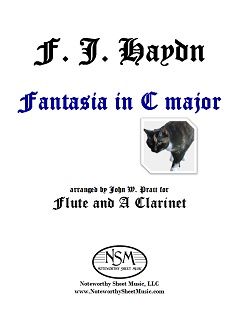 Fantasia in C major, by F. J. Haydn
Fantasia in C major, by F. J. Haydn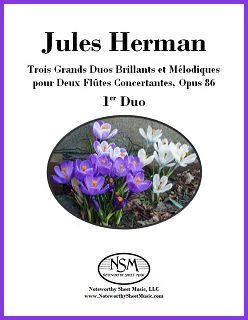 Trois Grands Duos Brillants et Mélodiques pour Deux Flûtes Concertantes, by Jules Herman
Trois Grands Duos Brillants et Mélodiques pour Deux Flûtes Concertantes, by Jules Herman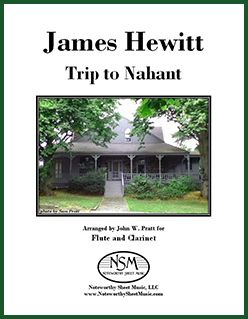 Trip to Nahant, by James Hewitt
Trip to Nahant, by James Hewitt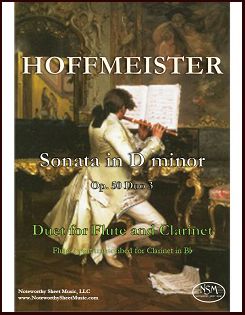 Sonata in D minor, Op.50, Duo 3, by Franz Anton Hoffmeister
Sonata in D minor, Op.50, Duo 3, by Franz Anton Hoffmeister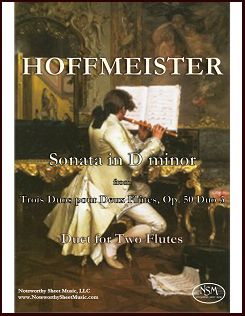 Sonata in D minor, Op.50, Duo 3, by Franz Anton Hoffmeister
Sonata in D minor, Op.50, Duo 3, by Franz Anton Hoffmeister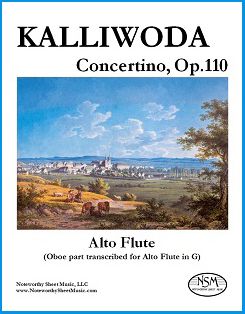 Concertino, Op.110, by J. W. Kalliwoda
Concertino, Op.110, by J. W. Kalliwoda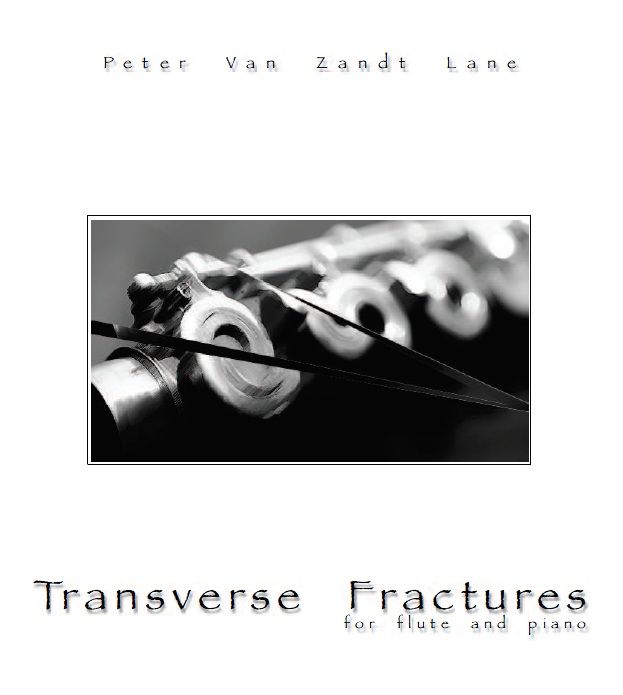 Transverse Fractures, by Peter Van Zandt Lane
Transverse Fractures, by Peter Van Zandt Lane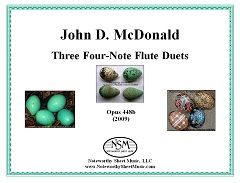 Three Four-Note Flute Duets, Op.448b, by John D. McDonald
Three Four-Note Flute Duets, Op.448b, by John D. McDonald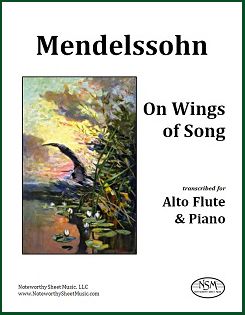 On Wings of Song, Op.34, No.2, by Felix Mendelssohn
On Wings of Song, Op.34, No.2, by Felix Mendelssohn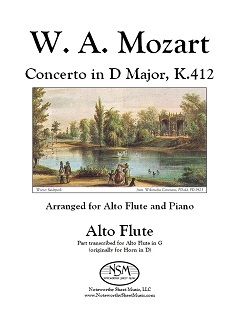 Concerto in D Major, K.412, by W. A. Mozart
Concerto in D Major, K.412, by W. A. Mozart 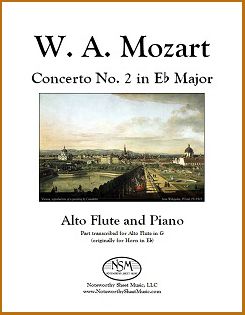 Concerto No.2 in E-flat major, K.417, by W. A. Mozart
Concerto No.2 in E-flat major, K.417, by W. A. Mozart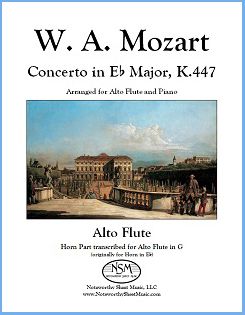 Concerto in E-flat Major, K.447, by W. A. Mozart
Concerto in E-flat Major, K.447, by W. A. Mozart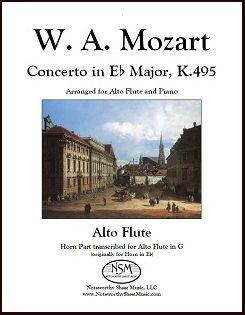 Concerto in E-flat Major, K.495, by W. A. Mozart
Concerto in E-flat Major, K.495, by W. A. Mozart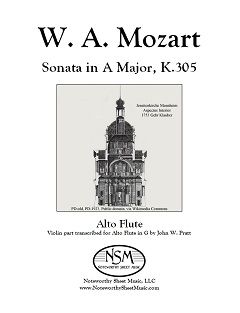 Sonata in A Major, K.305, by W. A. Mozart
Sonata in A Major, K.305, by W. A. Mozart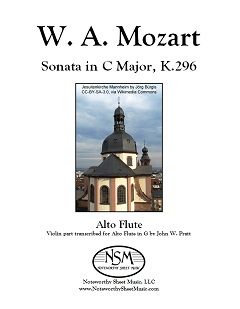 Sonata in C Major, K.296, by W. A. Mozart
Sonata in C Major, K.296, by W. A. Mozart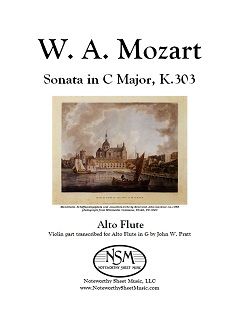 Sonata in C Major, K.303, by W. A. Mozart
Sonata in C Major, K.303, by W. A. Mozart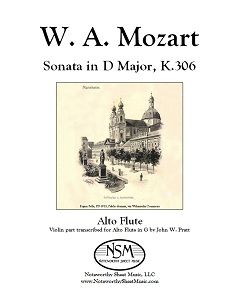 Sonata in D Major, K.306, by W. A. Mozart
Sonata in D Major, K.306, by W. A. Mozart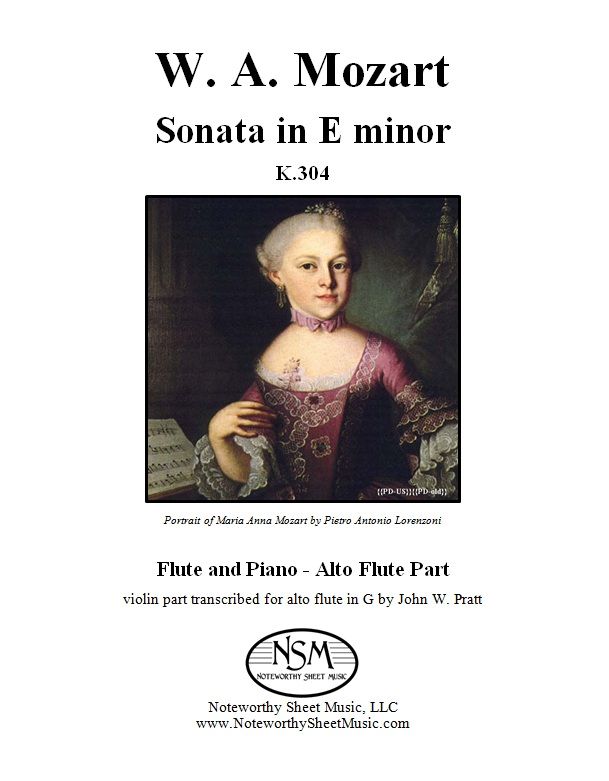 Sonata in E minor, K.304, by W. A. Mozart
Sonata in E minor, K.304, by W. A. Mozart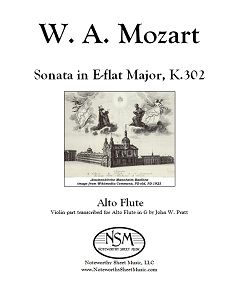 Sonata in E-flat Major, K.302, by W. A. Mozart
Sonata in E-flat Major, K.302, by W. A. Mozart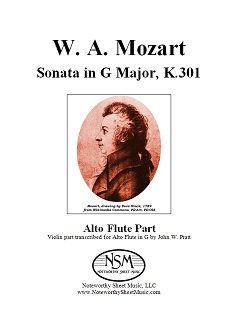 Sonata in G Major, K.301, by W. A. Mozart
Sonata in G Major, K.301, by W. A. Mozart